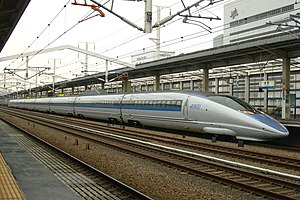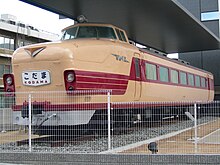Kodama(train)
 JR West 8-car500 Series Shinkansenon aKodamaservice atHimeji Station,August 2009 | |
| Overview | |
|---|---|
| Service type | Shinkansen(Local) |
| Status | Operational |
| First service | 1958 (Limited express) 1 October 1964 (Shinkansen) |
| Current operator(s) | JR Central,JR West |
| Route | |
| Termini | Tokyo(Tōkaidō Shinkansen) Shin-Osaka(Tokaido ShinkansenandSan'yō Shinkansen) HakataorHakataminami(San'yō Shinkansen) |
| Line(s) used | Tokaido Shinkansen San'yō Shinkansen |
| On-board services | |
| Class(es) | Green/standard |
| Catering facilities | None |
| Technical | |
| Rolling stock | 500/700/N700 series |
| Track gauge | 1,435 mm(4 ft8+1⁄2in) |
| Electrification | 25 kV AC overhead |
| Operating speed | 285 km/h (175 mph)[1] |
Kodama(こだま,"Echo" )is one of the three train services running on theTōkaidōandSan'yō Shinkansenlines. Stopping at every station, theKodamais the slowest Shinkansen service for trips between major cities such asTokyoandOsaka.The Kodama trains are used primarily for travel to and from smaller cities such asAtami.Travelers between major cities generally take theNozomiorHikariservices, which make fewer stops, although the former is not covered under theJapan Rail Passwhile theKodamais,[2]making these services an affordable alternative.
Services
[edit]Kodamatrains generally run over shorter distances thanNozomiandHikaritrains. TypicalKodamaruns include Tokyo - Nagoya / Shin-Osaka, Tokyo - Mishima / Shizuoka / Hamamatsu, Mishima / Shizuoka / Nagoya - Shin-Osaka, and Shin-Osaka / Okayama / Hiroshima - Hakata as well as some shorter late-night runs.
The trainsets used forKodamaservice are the same700 series,andN700 seriestrains used for theHikariandNozomiservices. Older100 seriesand300 seriestrains were also used forKodamaservices on the Sanyō Shinkansen until they were withdrawn in 2012. In December 2008, reconfigured500 seriestrains enteredKodamaservice to replace the withdrawn Sanyō Shinkansen0 seriestrains. Many Sanyō ShinkansenKodamaservices continue to and fromHakata-Minamion theHakata-Minami Line.
MostKodamatrains have both reserved and non-reserved cars; however, some morningKodamatrains to Tokyo and evening trains departing Tokyo have non-reserved cars only to accommodate commuters living inKanagawaandShizuoka.
The newest shinkansen trainset, theN700,is currently used on some early morning and late nightKodamaruns betweenKokuraandHakatastations inKyushu.All standard-class cars are non-reserved, and, as with all other N700 services, there is no smoking on these trains except in designated on-board smoking rooms.
At most intermediate stations,Kodamatrains wait for faster trains, including theNozomi,Hikari,Sakura,andMizuho,to pass through before resuming their journeys.
Stopping patterns (as of January 2024)
[edit]Kodamatrains stop at all stations between Tokyo and Hakata. In order from east to west, this comprisesTōkyō,Shinagawa,Shin-Yokohama,Odawara,Atami,Mishima,Shin-Fuji,Shizuoka,Kakegawa,Hamamatsu,Toyohashi,Mikawa-Anjō,Nagoya,Gifu-Hashima,Maibara,Kyoto,Shin-Ōsaka,Shin-Kōbe,Nishi-Akashi,Himeji,Aioi,Okayama,Shin-Kurashiki,Fukuyama,Shin-Onomichi,Mihara,Higashi-Hiroshima,Hiroshima,Shin-Iwakuni,Tokuyama,Shin-Yamaguchi,Shin-Shimonoseki,Asa,Kokura,andHakata station.
NoKodamaservice operates the entire distance from Tokyo to Hakata. For this reason, a transfer is required at Shin-Osaka in order to proceed in either direction.
Rolling stock
[edit]- 500 series8-car V sets
- 700-7000 series8-car E sets
- N700A series16-car X/K sets, modified from Z/N sets
- N700 series8-car S/R
-
JR West 500 seriesKodama,August 2010
-
JR West N700 series, April 2009
Former rolling stock
[edit]- 0 series
- 100 series
- 300 series
- 500 series(16-Car W Set)
- 700-0 series
- 700-3000 series
-
0 seriesKodamain July 2003
-
JR West 100 Series on a Sanyō ShinkansenKodamaservice in October 2008
-
JR West 300 series on 8 October 2008
-
JR Central 700 series, April 2009
Pre-Shinkansen
[edit]Formations
[edit]N700 series (16 cars)
[edit](All cars are no smoking except for smoking compartments located in cars 3, 7, 10, and 15.)
| ←Hakata | Tokyo→ | ||||||||||||||
| 1 | 2 | 3 | 4 | 5 | 6 | 7 | 8 | 9 | 10 | 11 | 12 | 13 | 14 | 15 | 16 |
|---|---|---|---|---|---|---|---|---|---|---|---|---|---|---|---|
| NR | NR | NR | NR | NR | NR | R | G | G | G | R | R | R | NR | NR | NR |
500 series (eight cars)
[edit](All cars are no smoking except for smoking compartments in cars 3 and 7.)
| ←Hakata | Shin-Osaka→ | ||||||
| 1 | 2 | 3 | 4 | 5 | 6 | 7 | 8 |
|---|---|---|---|---|---|---|---|
| NR | NR | NR | NR | NR | R | NR | NR |
N700 series (eight cars)
[edit](All cars are no smoking except for smoking compartments in cars 3 and 7.)
| ←Hakata | Shin-Osaka→ | |||||||
| 1 | 2 | 3 | 4 | 5 | 6 | 7 | 8 | |
|---|---|---|---|---|---|---|---|---|
| NR | NR | NR | NR | R | R | G | NR | NR |
700 series (eight cars)
[edit](All cars are non-smoking.)
| ←Hakata | Shin-Osaka→ | ||||||
| 1 | 2 | 3 | 4 | 5 | 6 | 7 | 8 |
|---|---|---|---|---|---|---|---|
| NR | NR | NR | NR | NR | NR | NR | C |
- G: Green car (first class) (reserved seating)
- R: Standard class reserved seating
- C: Standard class reserved seating + compartments
- NR: Standard class non-reserved seating
History
[edit]Limited expressKodama
[edit]
Kodamadebuted as alimited expressservice on the Tokaido Main Line on 1 November 1958. Services used151 seriestrainsets. This was the firstEMUtrain service of theJapanese National Railwaysclassified as a limited express, the highest (fastest) of train types on the national railway system. The train travelled betweenTokyo StationandOsaka Stationin six hours and 50 minutes and first enabled passengers to go and return between the two cities in one day. This is why the train was namedKodama,or echo.[citation needed]
Anarrow gaugeworld speed recordof 163 km/h was established by a 151 seriesKodamatrainset on 31 July 1959.[3]The conventionalKodamatrain ran until 30 September 1964, the day beforeKodamadebuted on the Shinkansen.[citation needed]
ShinkansenKodama
[edit]The shinkansenKodamaservices began on 1 October 1964, operating between Tokyo and Shin-Osaka.
On 17 March 2012, the remaining100 series(K) sets were withdrawn fromKodamaservices and700 series(8-car E set)Kodamaservices became entirely no-smoking.[4]Onboard trolley refreshment services were discontinued on all JR CentralKodamaservices from 17 March 2012.[5]Also, some of the 16-car500 seriesthat used to run as theNozomiservice were cut short to eight cars to run as theKodamaservice.
In an announcement by JR Central, JR West, and JR Kyushu made on 17 October 2023, the companies stated that all onboard smoking rooms on the Tokaido, San'yo, and Kyushu Shinkansen trains would be discontinued by Q2 2024;[6]this took effect on 16 March 2024.[7]
See also
[edit]References
[edit]- ^JR tân càn tuyến & đặc cấp liệt xa ファイル[JR Shinkansen & Limited Express Train File]. Japan: Kōtsū Shimbun. 2008.ISBN978-4-330-00608-6.
- ^"About JAPAN RAIL PASS | JAPAN RAIL PASS".japanrailpass.net.Retrieved12 September2023.
- ^"- YouTube".YouTube.
- ^Bình thành 24 xuân ダイヤ cải chính について[March 2012 Timetable Revision Details](PDF).News Release(in Japanese). Japan: West Japan Railway Company. 16 December 2011. Archived fromthe original(PDF)on 16 December 2011.Retrieved17 December2011.
- ^Nhất bộ liệt xa の xa nội phiến mại の thủ chỉ め cập び kiến trực しについて[Discontinuation and revision of on-train sales for certain trains](PDF).News Release(in Japanese). Japan: Central Japan Railway Company. 2012.Retrieved11 March2012.[permanent dead link]
- ^Kinoshita, Kenji (17 October 2023)."Đông hải đạo ・ sơn dương ・ cửu châu tân càn tuyến の xa nội cật yên ルーム, 2024 niên xuân にすべて廃 chỉ"[All smoking rooms on Tokaido, Sanyo, and Kyushu Shinkansen trains will be discontinued in spring 2024.].MyNavi Corporation.Archivedfrom the original on 18 October 2023.Retrieved19 October2023.
- ^"Smokers bitter as cigarettes banned on all Shinkansen lines | The Asahi Shimbun: Breaking News, Japan News and Analysis".The Asahi Shimbun.Retrieved1 April2024.










